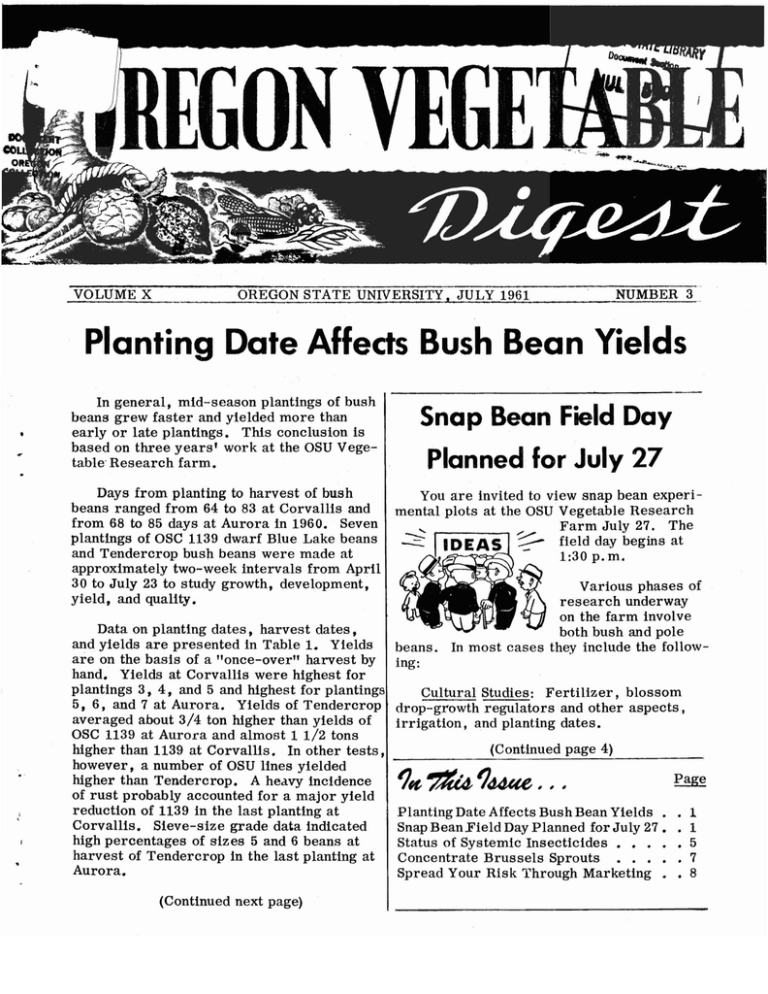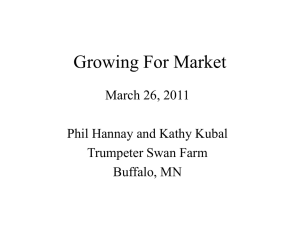Document 11039566
advertisement

VOLUME X OREGON STATE UNIVERSITY. JULY 1961 NUMBER 3 Planting Date Affeds Bush Bean Yields In general, mid-season plantings of bush beans grew faster and yielded more than early or late plantings. This conclusion is based on three years' work at the OSU Vege­ table' Research farm. Days from planting to harvest of bush beans ranged from 64 to 83 at Corvallis and from 68 to 85 days at Aurora in 1960. Seven plantings of OSC 1139 dwarf Blue Lake beans and Tendercrop bush beans were made at approximately two-week intervals from April 30 to July 23 to study growth, development, yield, and quality. Data on planting dates, harvest dates, and yields are presented in Table L Yields are on the basis of a "once-over" harvest by hand. Yields at Corvall1s were highest for plantings 3, 4, and 5 and highest for plantings 5, 6, and 7 at Aurora. Yields of Tendercrop averaged about 3/4 ton higher than yields of OSC 1139 at Aurora and almost 1 1/2 tons higher than 1139 at Corvallis. In other tests, however, a number of OSU lines yielded higher than Tendercrop. A heavy incidence of rust probably accounted for a major yield reduction of 1139 in the last planting at Corvallis. Sieve-size grade data indicated high percentages of sizes 5 and 6 beans at harvest of Tendercrop in the last planting at Aurora. (Continued next page) Snap Bean Field Day Planned for July 27 You are invited to view snap bean experi­ mental plots at the OSU Vegetable Research ,., Farm July 27. The :::::::- field day begins at 1:30 p. m. I~ Various phases of research underway on the farm involve both bush and pole' beans. In most cases they include the follow­ ing: r Cultural Studies: Fertilizer, blossom drop-growth regulators and other aspects. irrigation, and planting dates. (Continued page 4) 1" ~ 144«e , , , Page Planting Date Affects Bush Bean Yields . Snap BeanField Day Planned for July 27. Status of Systemic Insecticides • • • . Concentrate Brussels Sprouts • . • • Spread Your Risk Through Marketing • . . • • • 1 1 5 7 8 2 Bush Bean Yields ... (Continued from page 1) Grade distribution data and calculated value of bush beans at Corvallis are presented in Table 2. The patterns of development to first bloom and to harvest of beans planted on different dates at Corvallis are given in Table 3. In 1960 heat unit accumulation (heat units in degree days--base temperature of 50 0 F. subtracted from daily average of minimum and maximum temperatures) from planting to harvest ranged from 1,050 to 1,350 for the seven plantings at Corvallis. In general, emergence of 1139 was one to three days faster than Tendercrop, although harvest date of Tendercrop was one to three days earlier than for 1139. Plantings made in June had the shortest time interval from planting to harvest while those made earlier or later required a longer time interv'al to reach harvest maturity (note Table 3). It would also appear from these data that plantings made after mid-July would not be ready for harvest until mid-October or later. There would be a question in most years as to feasibility of commercial harvest of bush beans after October 1 in the Willamette Valley. Quality studies made on canned samples of beans of sieve sizes 3 and 5 at each of the harvests, or plantings, indicated that percent fiber of the two types was practically parallel at each harvest date. There was a decrease in fiber in the last two harvests of both 1139 and Tendercrop which was probably associated with cooler temperatures during pod develop­ ment. Beans from the last harvest were darker green in color than beans from earlier harvests. Sieve size 5 beans were distinctly lighter in color than sieve 3 beans. Although tllese data are of a preliminary nature, further studies are being conducted this summer on growth of bush beans planted at different times. Should tllere be considerable expansion of bush-bean~acreagein this area, scheduling of plantings would be important in attempting to maintain an even flow of the raw product into processing plants. --H. J. Mack and W. A. Frazier I-Iorticulture Department --R. M. Bullock North Willamette Experiment Station --W. A. Sistrunk Food & Dairy Technology Department A A A 4. Oregon's Vegetable Digest is published four times a year by the Agricultural Experiment Station, Ore­ gon State University, Corvallis. F. E. Price, Director. Address correspondence to the author c'oncerned or to the Department of Horticulture. Material Inay be rcprinted providing no endorSC111cnt of a cOlnnlercial product is stated or ilnplied. I~leasc credit Oregon State lJniverslty. '1"0 'silllplify technical tenninology, trade n~llnes of products or equipl11cnt SOI11etinles will be used. ~J () endOrSClllent of products nanlcd is intended nor is criticisl11 il11plied of products not 111entioned. 3 Table 1. Influence 'of planting dates on harvest dates and yield of ase 1139 and Tendercrop bush beans-­ Corvallis and Aurora t 1960 Corvallis Planting date Harvest date Yield--Tons/A T.e. 1139 T.e. 1139 4/30 7/16 7/18 5.8 5.4 4/30 7/21 2.3 1.8 5/9 7/19 7/20 5.0 4.9 5/10 8/3 3.5 2.7 5/23 7/30 8/1 6.1 6.8 5/27 8/11 2.5 2.1 6/7 8/10 8/12 7.5 6.4 6/9 8/16 4.2 2.9 6/21 8/24 8/24 8.6 5.6 6/23 8/31 3.5 4.2 7/5 9/14 9/16 6.9 4.6 7/8 9/17 4.1 3.2 7/19 10/6 10/10 5.6 2.f 7/23 10/10 6.1 4.7 Table 2. Grade distribution and calculated value of bush beans -- Corvallis, 1960 asc • Aurora Planting date Harvest date Yield--Tons/A 1139 T.e. % in Sieve sizes 5 6 1-2-3 4 Planting date 1 April 2 May 3 May 4 June 5 June 6 July 7 July 30 9 21 16 37 19 23 7 11 20 16 18 14 5 14 17 14 19 25 21 21 Tendercrop 1139 36 6 47 16 50 18 38 25 46 22 40 30 44 10 Yield Gross (Tons/A) (value $) 5.44 4.92 6.8:3 6.36 5.64 4.58 2.06 598 487 662 609 546 425 241 Gross Yield % in Sieve sizes 6 (Tons/A) (value $) 5 1-2-3 4 19 15 18 24 42 21 25 15 9 12 18 9 8 11 10 14 52 12 49 8 45 21 40 35 28 35 26 49 5.81 5.05 6.11 7.47 8.55 6.91 5.59 599 514 645 729 730 535 437 Arbitrary values for comparison: $145 per ton for sieve size 1-2-3; $115 per ton for sieve size 4; $92.50 per ton for sieve size 5; $65 per ton for sieve size 6; no value for sizes above 6. (Continued next page) 11~1tde/ Leopold and Lam, in recent experiments on removal of leaves from seedlings of early and late varieties of tomatoes, have shown that leaf removal promotes relatively early flowering of late varieties, but has little effect on early varieties. This research may offer a clue to the relatively favorable behavior of late varieties in the Milton-Freewater area of Oregon, where considerable pruning of plants is sometimes practiced. (Proc. Amer. Soc. Hort. Sci. 76: 543-547. 1960.) • • • 4 Table 3. Growth of bush beans planted at different dates -­ 1952, 1959 t 1960, Corvallis 1952 (Processor) Heat units First First Pl. date bloom Harvest bloom Harvest Days to: April!l April 25 9 May May 25 June 9 June 24 July 8 525 479 59 57 53 90 45 42 73 522 70 38 66 575 662 40 71 768 90 83 530 1959 (OBC 734) Days to: Heat units -­ April 25 May 10 May 20 57 -­ -- ........ -­ 43 511 554 553 904 925 1036 -­ -­ -­ 82 70 67 -­ -­ --­ ---­ July 19 42 76 868 April 30 9 May May 23 June 7 June 21 July 5 July 19 -­ -­ -­ -­ --­ --­ -- ... .-.., .... ..---­ 1329 Heat units in degree days using 50 0 on Processor bush beans. 1121 1212 1960 (OBC 1139) Heat units First First Pl. date bloom Harvest bloom Harvest --­ 50 1067 1104 Days to: First First Pl. date bloom Harvest bloom Harvest -­ 885 1009 1095 F~ -­ 54 49 46 40 37 39 44 -­ 79 72 70 66 64 73 83 --­ 581 576 726 694 737 818 810 ... _... ­ 1061 1041 1226 1250 1237 1342 1326 base temperature; 1952 work by S. B. Apple, Jr. , ~ Snap Bean Field Day . .. • A A (Continued from page 1) Breeding: Blue Lake bu~h development, improvement of pole beans, and resistance to rootrot, rust, and yellow mosaic. Weed Control Entomological Studies: Symphylids ~ slugs, and nitidulids controls. Breeding, cultural, weed control, and insect control wor k also is being conducted on other vegetable crops and results may be observed. To reach the Vegetable Research Farm, cross the V~n> Buren Street bridge going east from Corvallis, turn left on Smith IJane about one- half mile from the bridge; turn right, then left through the "cut" and immediately onto the farm. Parking areas will be designated. A £. A A 5 Status of Systemic Insecticides Summarized During the past 10 years the development of "systemic" insecticides has created consid­ erable interest. These materials, when applied to the foliage of plants or placed in the soil t are absorbed and translocated, usually towards the growing tips, where they kill pests feed­ ing on plant juices or tissues. The .idea" although not ne\v ,has fascinating possibilities for plant protection. A toxic material within the plant can mini1niz·e danger to beneficial para­ sites and predators and therefore supplement natural or biological control of plant pests. As plants grow, the new tissue is not protected by conventional insecticides without repeated applications. Systemic insecticides have the ability to protect new growth over long periods of time. A recent publication of the Agricultural Research Service of the U. S. Department of A.griculture (ARS Special Report, A.RS 22-61, Sept. 1960) summarizes the available informa­ tion on these systemic insecticides -- their history, present status, and what the future may hold. Twenty or more insecticides have been discovered to have systemic properties, but only a half dozen have so far been seriously considered for use on horticultural crops. Research has yet to find $ .~ why some chemicals have systemic properties and others do not. .,,,....,,....... '"1 Several of the insecticides which are absorbed by plants are known to be changed chemically by the plant metabolism into compounds more toxic than the original material. This fact complicates the problem of establishing safe use of systemics in food crops. The history of systemic behavior goes back at least -to the 15th century to Leonardo da Vinci's experiments with arsenic injected into pea.ch trees to kill pests feeding on them. Unfortunately, this also made the fruits poisonous to human beings. Other materials, particularly selenium compounds, have been shown to be systemic insecticides, but the dis­ covery of the organic phosphorus systemics occurred less than 15 years ago with Gerhard Schrader's work in Germany. Progress along this line has accelerated during the past 4 or 5 years. The USDA report lists 7 systemics which it says are now in use in the United States or which will probably be in use soon. Our knowledge of three of these chemicals has advanced to the stage where they have been included in the vegetable section of the Oregon Insect Control Handbook recommendations for 1961: Demeton (Systox), effective against aphids and mites, works systemically for a week or two after one application to the foliage or soil. It is in the parathion class of high toxicity to higher animals. Phosdrin is unique in having a very short toxic life (one to three days) in plants. It is not only effective against sucking insects, but also shows great promise for control of certain chewing pests and has Federal registration on a number of vegetable crops. It is also highly toxic to higher animals and must be handled with great caution. Phorate (Thimet) is used mostly as a seed or soil treatment where it is absorbed, converted into highly insecticidal substances, and translocated by the plant. 'Its toxic life is quite long, giving protection from aphids, mites, and certain other pests on some crops for as long as two months. It is also included in the highly toxic category for higher animals. (Continued next page) 6 Status of Systemic Insecticides ... (Continued from page 5) Two other materials discussed in th.e USDA. report,. which show great promise'for gen­ eral use in the near future~ are Di-syston and phosphamidon. The former is most effective .when used as a soil treatment, as in the case of phorate. Phosphamidon is water soluble, which may lessen the danger of toxic residues remaining in oily or waxy food plants. It Shows great promise against a number of chewing and sucking insect pests. Since this report was published (Septembe;r 1960) several new developments have taken place. For example, methyl demeton (meta-Systox) is mentioned as being largely abandoned in favor of the more toxic demeton. Actually the methyl form haS been found to have distinct advantages t such as qUick knockdown (important in the control of vectors of plant virus diseases), as well as being appreciably less toxic to mammals than demeton. Research is continuing to find where methyl demeton will fit into the plant protection picturect A new phosphate systemic has recently been introduced from England (called Menazon or PP 175) which has the advantage over previously discovered systemics of being of very low mam­ malian toxicity. Its action is slow, but persistent, and it may find a place in horticulture as a preventative of aphid and mite bu.ildups, rather than a control for existing insect popula­ tions. Why are we not making more and better use of the systemic insecticides? A number of reasons are pointed out in the USDA report, the primary ones being (1) the limited spectruff1 of insect pests susceptible to the chemicals so far discovered, (2) the problem of toxic resi­ dues remaining in the food plant at harvest, and (3) the fact that most of the systemics are highly toxic to human beings and thus hazardous to use. Research is continuing to find answers to these and other questions associated with the use of tl1ese interesting pestici.des. -- H. H. Crowell Entomology Department • • A & 11~1ttJtu. Kaplan and Macneish have recently reported finding remains of pods of a "wildu type runner bean at cave levels in Mexico datil1g back 7500 to 9000 years. Remains of the "garden" bean dated back 4300 to 6000 years; lima bean only 500 to 1800 years ago. (Bot., Mus. Leafl. Harv ~ IB: 33-56.. 1960.) • • • Zink and Kimble have recently shown that infection of lettuce with mosaic virus call~es the most serious losses in crop yield when infection occurs early in growth of the plant" Use of disease-free seed is one means of reducing losses from the virus. Proc. Amer .. SOCt; Hort. Sci. 76: 448-454.. 1960., • • • 7 Concentrate Brussels Sprouts for Easier Harvest Even Brussels sprouts may yet give way to mechanized harvesting I If the terminal growing point is removed by making a small slanting cut with a sharp knife to remove the tip of the stem, most of the axillary-buds will begin growth. In two years of very limited testing at Corvallis it has been observed that the best time to remove the ter­ minal growing point is when the first sprouts at the base of the stem are 3/8 to 1/2 inch in diameter. Sprouts were subsequently harvested by stripping off the leaves, pulling the plants out by the roots, taking them indoors, and cutting off the sprouts with a sharp knife. It is conceivable that such a technique might be refined and the operation expanded so that successive portions of an acreage could be topped at intervals to provide a sequence of har­ vest. Plants could probably be cut off rather than uprooted (though the mature stems are surprisingly tough), and the sprouts and leaves cut off by putting the stem through a circular set of knives similar to a corn cutter. Leaves and sprouts could then be separated by large mesh, screens. The F-l hybrid variety Jade Cross was uniform in growth and was better adapted to this technique than was Catskill. Jade Cross was more susceptible to frost injury in late fall. References describing this technique have not been found but it is believed that credit belongs to the Unilever research organization, Sharnbrook, Bedford, England. Left-not topped. Note retarded development of 'buds on upper half of stem. Right-terminal growing point removed when first sprouts were 3/8 to 1/2 inch in diam­ eter. Note uniform development of sprouts throughout length of stem. Variety-Catskill. ...• ,,~~~~" ,~~, . -,.;,., ." '. '~: .h -If 'jA;,.4.~bi( " ..... .. '711'*; '"' g' '. -"" J .<: ........... '.,.., . .. ~ •.1.. All plants in this group were topped. Development of sprouts was about the same at the time this picture was taken, ahhough the treatment in this case included top­ ping of three of those plants 10 days later. leaves were removed just before picture was taken. 'I 'I. --oJ .. ~ \ ~:-::- .- ~ . . r·.' :- .... ~ ....... .... ~ ..'t ~- ....'lo,' '..of ... T, '.:::" I} 1°­ '.-J~ --Andrew A. Duncan Horticulture Department • • • • 8 Spread Your Risk Through Marketing Not every vegetable grower in Oregon can afford to operate a roadside stand, but tllere are many who can't afford not to! The cost-price squeeze is continuing to eat up the small­ vo~ume producer as is shown by U. S. Census data on agriculture. Everyone in agriculture is concerned about this situation, but for different reasons. However, outside of agriculture the same type of thing is happening with far less concern or at least far less publicity. In agriculture, mergers and consolidations are not as frequent as in the nonagricultural businesses. Instead 9f merging or consolidating with some other firm. agricultural business usually makes an outright sale or goes broke. The nonagricultural firm often merges with its competitor to maintain or take a larger share of the market; thus both firms survive. Another quite common practice is a merger between two firms in separate industries in order to maintain income and spread risk. Vegetable growers wanting to maintain complete control of their resources and decision­ making prerogatives may want to consider the possibility of operating another firm -- that of fresh market sales. Last year just under 12,400 carloads of fresh fruits and vegetables were unloaded at Portland, Oregon. These cars contained 56 different fruits and vegetables, many of which can be produced here in Oregon. This does not reflect the volume of produce items that was unloaded in other cities of the state. We know that a good many trucks, cars, and other commercial conveyances come into Oregon from Washington, Idaho, and California. They are unloaded prior to reaching Portland. Therefore t it Is easy to conclude that Ore.goll does use a large volume of fruits and vege­ tables in fresh form and that much of this volume comes from other states. The potential is here, but it is not being exploited. Some farmers are in an ideal position to get into the fresh market business by starting roadside stands. A roadside stand does not have to be an elaborate setup, the first few years. It can grow and expand as business warrants and as time and resources permit. The roadside-stand business today Is almost a natural. Consider a few of the changes in our mode of living that have taken place in the past decade: (1) The growth of urban centers; (2) improved roads linking these urban centers; (3) increased use of automobiles; (4) shorter ·working hours and more leisure time; (5) an increased number of tourists visiting Oregon; and (6) more people working in the cities and living in the urban or rural areas. These factors contribute to the success of a roadside stalld. Despite the fact that a great many consumers buy and use the so-called "convenience­ type foods" there comes a time when a desire for some good, fresh fruits and vegetables will turn the food buyer from the produce counter toward the farm. (Continued next page) 9 Fresh Marketing ... (Continued from page 8) If a roadside stand is on his way to the crowded shopping center it will serve as a magnet to draw him in. If the display of fresh fruits and vegetables Is attractive, impulse buying may take place and another family may decide to buy and eat fresh produce in season. For a roadside stand the following principles should .be reviewed and studied: (1) A good location on a busy road. (2) A neat stand with tidy, pleasant surroundings. (3) Ample, convenient parking space. (4) Well planned signs and other advertising. (5) Adequate volume of good quality produce. (6) Pricing that is consistent with quality and competition. (7) A well maintained and well arranged display. (8) Honest weight and courteous service. (9) A real interest in people -- prospective customers. Once the roadside stand is established, merchandising techniques are easily acquired. However, main consideration should be given to display. A good produce display has eye appeal, shows good management, and makes shopping easy. Clearly marked price tags on every item encourage buying and help build volume. Packaging is also helpful; it encourages impulse buying and makt!.s produce easier to handle. However, there should be enough variation in package size to fit the needs of all sizes of families from two to six. It is also well to let the customer know that bulk quantities are available at lower prices. This will encourage home canning and freezing and a greater volume of dollar sales. A combination packing house and roadside stand allows the farmer to sell his produce through fresh market outlets and affords him an additional outlet for his entire production. This activity is similar to one nonagricultural firm merging with another to maintain.a larger share of the market or to spread marketing risks. --R. H. Groder Extension Marketing Specialist • A. A. •






